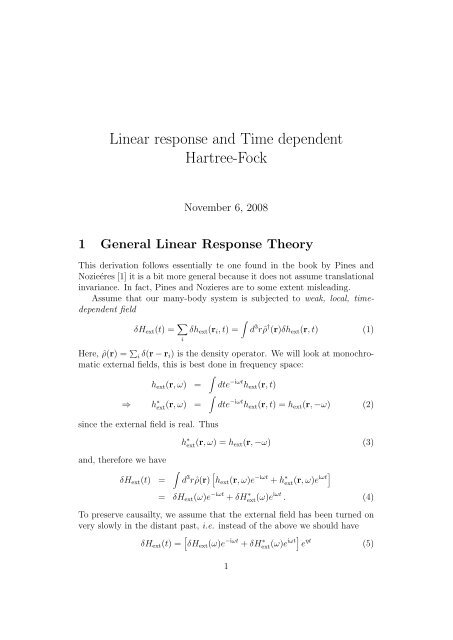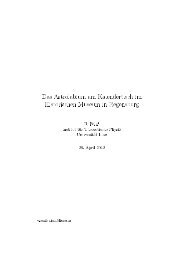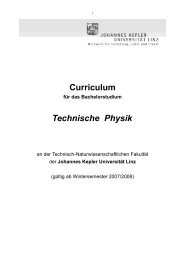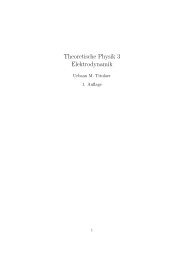Linear response and Time dependent Hartree-Fock
Linear response and Time dependent Hartree-Fock
Linear response and Time dependent Hartree-Fock
You also want an ePaper? Increase the reach of your titles
YUMPU automatically turns print PDFs into web optimized ePapers that Google loves.
<strong>Linear</strong> <strong>response</strong> <strong>and</strong> <strong>Time</strong> <strong>dependent</strong><br />
<strong>Hartree</strong>-<strong>Fock</strong><br />
November 6, 2008<br />
1 General <strong>Linear</strong> Response Theory<br />
This derivation follows essentially te one found in the book by Pines <strong>and</strong><br />
Nozieéres [1] it is a bit more general because it does not assume translational<br />
invariance. In fact, Pines <strong>and</strong> Nozieres are to some extent misleading.<br />
Assume that our many-body system is subjected to weak, local, time<strong>dependent</strong><br />
field<br />
δH ext (t) = ∑ ∫<br />
δh ext (r i , t) = d 3 rˆρ † (r)δh ext (r, t) (1)<br />
i<br />
Here, ˆρ(r) = ∑ i δ(r − r i ) is the density operator. We will look at monochromatic<br />
external fields, this is best done in frequency space:<br />
∫<br />
h ext (r, ω) = dte −iωt h ext (r, t)<br />
∫<br />
⇒ h ∗ ext(r, ω) = dte −iωt h ext (r, t) = h ext (r, −ω) (2)<br />
since the external field is real. Thus<br />
<strong>and</strong>, therefore we have<br />
δH ext (t) =<br />
∫<br />
h ∗ ext(r, ω) = h ext (r, −ω) (3)<br />
d 3 rˆρ(r) [ h ext (r, ω)e −iωt + h ∗ ext(r, ω)e iωt]<br />
= δH ext (ω)e −iωt + δH ∗ ext(ω)e iωt . (4)<br />
To preserve causailty, we assume that the external field has been turned on<br />
very slowly in the distant past, i.e. instead of the above we should have<br />
δH ext (t) = [ δH ext (ω)e −iωt + δH ∗ ext(ω)e iωt] e ηt (5)<br />
1
with an infinitesimal parameter η.<br />
We now want to calculate the induced density fluctuation δρ(r, t) due<br />
to this external field. A priori, the infinitesimal perturbation causes an infinitesimal<br />
change in the ground state wave function:<br />
The change in density is then, to first order,<br />
|Ψ 0 〉 → |Ψ(t)〉 = |Ψ 0 〉 + |δΨ(t)〉 (6)<br />
δρ(t) = 〈Ψ(t)| ˆρ(r) |Ψ(t)〉 − 〈Ψ 0 | ˆρ(r) |Ψ 0 〉<br />
≈ 〈Ψ 0 | ˆρ(r) |δΨ(t)〉 + 〈δΨ(t)| ˆρ(r) |Ψ 0 〉 . (7)<br />
This δρ(t) is called the transition density because it is the transition matrix<br />
element of the density operator between the ground state |Ψ 0 〉 <strong>and</strong> the perturbation<br />
|δΨ(t)〉. The time dependence of the perturbation causes the same<br />
time dependence of the density fluctuation,<br />
δρ(r; t) ∼ δρ(r)e −iωt e ηt . (8)<br />
(This is to be taken with a little caution, of course the transition density also<br />
must be real.)<br />
The time <strong>dependent</strong> part of the wave function can be calculated by peerturbation<br />
theory.<br />
Ansatz for the solution<br />
i¯h ∂ ∂t |Ψ(t)〉 = (H + δH ext(t)) |Ψ(t)〉 . (9)<br />
|Ψ(t)〉 = ∑ n<br />
a n (t)e −iωnt |n〉 (10)<br />
where {E n , |n〉} ≡ {¯hω n , |n〉} is the energy/eigenfunction pair of the unperturbed<br />
Hamiltonian. The initial condition is a n (−∞) = δ n,0 . Inserting the<br />
above in the Schrödinger equation gives<br />
∑<br />
(i¯hȧ n (t) + E n a n (t)) e −iωnt |n〉 = ∑ (E n + δH ext (t))a n (t)e −iωnt |n〉<br />
n<br />
n<br />
∑<br />
i¯hȧ n (t) |n〉 = ∑ δH ext (t)a n (t)e −iωnt |n〉 (11)<br />
n<br />
n<br />
Now only a 0 (t) = 1 is 0 th order in δH ext (t), all other a n (t) are first order. We<br />
therefore need to keep only the first term on the right h<strong>and</strong> side. Projecting<br />
the equation on a state |n〉 then gives<br />
i¯hȧ n (t) = 〈n| δH ext (t) |0〉 e i(ωn−ω 0)t ≡ 〈n| δH ext (t) |0〉 e iω n0t<br />
(12)<br />
2
with ω n0 = ω n − ω 0 .<br />
We can now insert the perturbing Hamiltonian<br />
∫<br />
〈n| δH ext (t) |0〉 = d 3 r ′ 〈n| ˆρ(r ′ ) |0〉 [ h ext (r ′ )e −iωt + h ∗ ext(r ′ )e iωt] e ηt (13)<br />
we can write<br />
∫<br />
i¯hȧ n (t) = d 3 r ′ 〈n| ˆρ(r ′ ) |0〉 [ h ext (r ′ )e i(ωn0−ω)t+ηt + h ∗ ext(r ′ )e ] i(ω n0+ω)t+ηt<br />
e ηt<br />
or<br />
a n (t) =<br />
−<br />
(14)<br />
∫<br />
d 3 〈n| ˆρ(r) |0〉<br />
rh ext (r, ω)<br />
¯hω − ¯hω n0 + iη ei(ω n0−ω)t+ηt<br />
∫<br />
d 3 rh ∗ 〈n| ˆρ(r) |0〉<br />
ext(r, ω)<br />
¯hω n0 + ¯hω − iη ei(ω n0+ω)t+ηt . (15)<br />
(We can redefine η ↔ ¯hη because η is infinitesimal.)<br />
Inserting the expansion of |δΨ(t)〉 into the transition density gives generally<br />
δρ(r, t) = ∑ n>0<br />
a n (t) 〈0| ˆρ(r) |n〉 e −iω n0t + c.c.<br />
=<br />
−<br />
=<br />
∫<br />
∫<br />
∫<br />
d 3 r ′ h ext (r ′ ) ∑ n>0<br />
d 3 r ′ h ∗ ext(r ′ ) ∑ n>0<br />
〈0| ˆρ(r) |n〉 〈n| ˆρ(r ′ ) |0〉<br />
e −iωt+ηt<br />
¯hω − ¯hω n0 + iη<br />
〈0| ˆρ(r) |n〉 〈n| ˆρ(r ′ ) |0〉<br />
e iωt+ηt + c.c.<br />
¯hω + ¯hω n0 − iη<br />
d 3 r ′ h ext (r ′ ) ∑ n>0<br />
〈0| ˆρ(r) |n〉 〈n| ˆρ(r ′ ) |0〉 × (16)<br />
[<br />
]<br />
1<br />
×<br />
¯hω − ¯hω n0 + iη − 1<br />
e −iωt+ηt<br />
¯hω + ¯hω n0 + iη<br />
+c.c. (17)<br />
We can then define the coordinate space representation of the density-density<br />
reponse function as<br />
χ(r, r ′ ; ω) = ∑ [ 〈0| ˆρ(r) |n〉 〈n| ˆρ(r ′ ) |0〉<br />
− 〈0| ˆρ(r) |n〉 〈n| ]<br />
ˆρ(r′ ) |0〉<br />
. (18)<br />
n>0<br />
¯hω − ¯hω n0 + iη ¯hω + ¯hω n0 + iη<br />
We have already seen the definition of the dynamic structure function.<br />
We can immediately read off the relationship, noting that<br />
lim<br />
η→0<br />
1<br />
¯hω − ¯hω n0 + iη = πδ(¯hω − ¯hω n0) (19)<br />
3
<strong>and</strong> therefore, for ω >=<br />
Imχ(r, r ′ ; ω) = π ∑ n>0<br />
〈0| ˆρ(r) |n〉 〈n| ˆρ(r ′ ) |0〉 δ(¯hω − ¯hω n0 ) (20)<br />
(The definition of common factors <strong>and</strong> signs differs in different textbooks !)<br />
In scattering experiments, one observes the momentum transfer, so the<br />
∫<br />
χ(q, ω) = d 3 rd 3 r ′ e iq·(r−r′) χ(r, r ′ ; ω)<br />
= ∑ [ |〈0| ˆρq |n〉| 2<br />
n>0<br />
¯hω − ¯hω n0 + iη − |〈0| ˆρ q |n〉| 2 ]<br />
. (21)<br />
¯hω + ¯hω n0 + iη<br />
2 Excited state wave function <strong>and</strong> the action<br />
integral<br />
It comes now to the point where we must some definite model for the excited<br />
states of a physical system. This can not be done in general; we must make<br />
some approximations. With all the reservations one can have about the<br />
<strong>Hartree</strong>-<strong>Fock</strong> approximation, we start with that one.<br />
We approximate the wave function of excited states by<br />
|ψ(t)〉 = 1<br />
∑<br />
N (t) e−iE HF t/¯h e 1 2 ph c ph(t)a † pa h |φHF 〉 (22)<br />
where |φ HF 〉 is a <strong>Hartree</strong>-<strong>Fock</strong> ground state. E HF the <strong>Hartree</strong>-<strong>Fock</strong> energy<br />
expectation value, <strong>and</strong> the c ph (t) “particle–hole amplitudes”.<br />
N 2 (t) = 〈φ HF | e 1 2<br />
∑<br />
ph c∗ ph (t)a† h a p<br />
e 1 2<br />
∑<br />
ph c ph(t)a † pa h |φHF 〉 (23)<br />
is the normalization integral. Note that states that are labeled with<br />
h, h i , h ′ , . . . are understood to be occupied (“hole”) states (i.e. states that are<br />
present in the Slater determinant φ HF <strong>and</strong> states labeled with p, p i , p ′ , . . . are<br />
unoccupied “particle” states. As above, assume that the system is described<br />
by a Hamiltonian that is written in coordinate space as<br />
H = H 1 + V (24)<br />
H 1 = ∑ h(r i ) = ∑ ]<br />
[− ¯h2<br />
i<br />
i<br />
2m ∇2 i + U ext (r i )<br />
(25)<br />
V = ∑ v(r i , r j ) (26)<br />
i
or, in second quantized form<br />
H 1 = ∑ αβ<br />
〈α| h ext |β〉 a † αa β (27)<br />
V = 1 ∑<br />
〈αβ| v |γδ〉 a †<br />
2<br />
αa † β a δ a γ . (28)<br />
αβγδ<br />
We furthermore subject the system to a weak, scalar external field<br />
δH ext (t) = ∑ i<br />
δh ext (r i ; t) (29)<br />
or, in second quantized form,<br />
δH 1 (t) = ∑ αβ<br />
〈α| δh(t) |β〉 a † αa β . (30)<br />
Similar to the determination of the single-particle wave functions of the<br />
<strong>Hartree</strong>-<strong>Fock</strong> theory by a variational principle, the “particle-hole amplitudes”<br />
are determined by the “Kerman-Koonin” stationarity principle<br />
∫ t1<br />
δS = δ dtL(t) (31)<br />
t 0<br />
L(t) = 〈ψ(t)| H + δH ext − i¯h ∂ |ψ(t)〉 . (32)<br />
∂t<br />
We want to derive linear equations of motion, hence we must keep all<br />
second order terms in the Lagrangian. The driving quantity is the external<br />
perturbing field δH 1 (t) which is, by assumption, of first order. <strong>Linear</strong> equations<br />
of motion will lead to c ph (t) that are of the same order. Thus, to get<br />
linear equations of motion, we must keep the linear terms in c ph (t) with the<br />
perturbing field, <strong>and</strong> the quadratic terms in all others.<br />
Thus:<br />
〈ψ(t)| δH ext |ψ(t)〉<br />
≈ 1 ∑ [<br />
c<br />
∗<br />
2 ph 〈φ HF | a † h a pδH ext (t) |φ HF 〉 + c ph 〈φ HF | δH ext (t)a † pa h |φ HF 〉 ]<br />
= 1 2<br />
= 1 2<br />
= 1 2<br />
ph<br />
∑<br />
phαβ<br />
∑<br />
phαβ<br />
∑<br />
ph<br />
〈α| δh ext (t) |β〉 [ c ∗ ph 〈φ HF | a † h a pa † αa β |φ HF 〉 + c ph 〈φ HF | a † αa β a † pa h |φ HF 〉 ]<br />
〈α| δh ext (t) |β〉 [ c ∗ phδ α,p δ β,h + c ph δ β,p δ α,h<br />
]<br />
[<br />
c<br />
∗<br />
ph 〈p| δh ext (t) |h〉 + c ph 〈h| δh ext (t) |p〉 ] . (33)<br />
5
In the time derivative term we must be a bit more careful <strong>and</strong> keep the<br />
normalization N (t).<br />
〈ψ(t)| i¯h ∂ ∂t |ψ(t)〉 = E HF + i¯h 2 〈ψ 0(t)| ∑ ph<br />
= E HF + i¯h 4<br />
∑<br />
ph<br />
ċ ph (t)a † pa h |ψ(t)〉 − i¯h 2<br />
˙ N (t)<br />
N (t)<br />
〈ψ(t)| ċ ph (t)a † pa h − ċ ∗ ph(t)a † h a p |ψ(t)〉 (34) .<br />
This formula is still exact, we now exp<strong>and</strong> to second order. We can immediately<br />
leave out all terms that can be written as a time-derivative. Also, first<br />
order terms are zero because 〈φ HF | a † pa h |φ HF 〉 = 0. Hence<br />
〈ψ(t)| i¯h ∂ ∂t |ψ(t)〉<br />
= E HF + i¯h 4<br />
= E HF + i¯h 4<br />
∑<br />
〈φ HF | c ∗ p ′ h ′(t)ċ ph(t)a † h ′a p ′a† pa h − ċ ∗ ph(t)c p ′ h ′(t)a† h a pa † p ′a h |φ HF〉<br />
′<br />
php ′ h ′<br />
∑ [<br />
c<br />
∗<br />
ph (t)ċ ph (t) − ċ ∗ ph(t)c ph (t) ] . (35)<br />
ph<br />
It should also be noted that this term occurs under the time integral in the<br />
action (31), hence we can integrate by parts. In other words, the two term<br />
appearing above are the same.<br />
Finally we must exp<strong>and</strong> 〈ψ(t)| H − E HF |ψ(t)〉 to second order in the<br />
c ph (t). The E HF comes from the time-derivative term, it evidently cancels<br />
the zeroth order term in our expansion. The normalization integral (23) is<br />
to second order<br />
N 2 (t) ≈ 〈φ HF | 1 + 1 ∑<br />
c ph (t)a †<br />
2<br />
pa h + 1 ∑<br />
c ∗<br />
ph<br />
2<br />
ph(t)a † h a p + O(c 2 ph) |φ HF 〉<br />
ph<br />
= 1 + O(c 2 ph) (36)<br />
<strong>and</strong> has therefore no influence.<br />
Now<br />
〈ψ(t)| H − E HF |ψ(t)〉<br />
= 1 ∑ [<br />
c<br />
∗<br />
2 ph 〈φ HF | a † h a p(H − E HF ) |φ HF 〉 + c ph 〈φ HF | (H − E HF )a † pa h |φ HF 〉 ]<br />
ph<br />
∑<br />
+ 1 c ∗<br />
8<br />
phc ∗ p ′ h 〈φ HF| a † ′ h a pa † h ′a p ′(H − E HF ) |φ HF 〉<br />
pp ′ hh ′<br />
+ 1 ∑<br />
c ph c p<br />
8<br />
′ h ′ 〈φ HF| (H − E HF )a † pa h a † p ′a h |φ HF〉<br />
′<br />
pp ′ hh ′<br />
6
+ 1 ∑<br />
c ∗<br />
4<br />
phc p ′ h ′ 〈φ HF| a † h a p(H − E HF )a † p ′a h |φ HF〉 . (37)<br />
′<br />
pp ′ hh ′<br />
The situation is the same as the usual one in the theory of small oscillations:<br />
The first order terms must be zero in order to obtain a sensible second order<br />
equation. We must therefore require that<br />
〈φ HF | a † h a p(H − E HF ) |φ HF 〉 = 〈φ HF | (H − E HF )a † pa h |φ HF 〉 = 0 . (38)<br />
These conditions are called the “Brillouin conditions”. In the case of a<br />
<strong>Hartree</strong>–<strong>Fock</strong> ground state the condition is identical to the requirement that<br />
the single particle orbitals have been obtained by the <strong>Hartree</strong>-<strong>Fock</strong> equation.<br />
We can now turn to the evaluation of the second-order terms: In the terms<br />
that contain c ∗ phc ∗ p ′ h or c phc ′ p ′ h ′, the matrix element of E HF is taken between<br />
a 2p − 2h state <strong>and</strong> the ground state <strong>and</strong> is zero because of orthogonality<br />
〈φ HF | a † h a pa † h ′a p |φ HF〉 = 0. Moreover, the matrix element of the one-body<br />
′<br />
part of the Hamiltonian is zero:<br />
〈φ HF | a † h a pa † h ′a p ′H 1 |φ HF 〉 = ∑ αβ<br />
〈α| h |β〉 〈φ HF | a † h a pa † h ′a p ′a† αa β |φ HF 〉 = 0 (39)<br />
because, for example α = p <strong>and</strong> β = h <strong>and</strong> then we would have the overlap<br />
between a 1p-1h state <strong>and</strong> the ground state. Therefore, this term has<br />
contributions form the pair potential only:<br />
〈φ HF | a † h a pa † h ′a p ′V |φ HF〉 = 1 2<br />
Likewise, we get<br />
= 1 2<br />
= 1 2<br />
∑<br />
αβγδ<br />
∑<br />
αβγδ<br />
∑<br />
αβγδ<br />
〈αβ| v |γδ〉 〈φ HF | a † h a pa † h ′a p ′a† αa † β a δ a γ |φ HF 〉<br />
〈αβ| v |γδ〉 〈φ HF | a † h a pa † h ′a p ′a† αa † β a δ a γ |φ HF 〉<br />
〈αβ| v |γδ〉 [δ αp δ βp ′ − δ αp ′δ βp ] [δ δh ′δ γh − δ δh δ γh ′]<br />
= 〈pp ′ | v |hh ′ 〉 a<br />
(40)<br />
〈φ HF | V a † pa h a † p ′a h ′ |φ HF〉 = 〈hh ′ | v |pp ′ 〉 a<br />
. (41)<br />
Finally we need to work out the last term in Eq. (37). We have to<br />
distinguish four cases, namely p = p ′ , h = h ′ , p = p ′ , h ≠ h ′ , p ≠ p ′ , h = h ′<br />
<strong>and</strong> p ≠ p ′ , h ≠ h ′ . The case p = p ′ , h = h ′ has already been worked out, we<br />
have obtained<br />
〈φ HF | a † pa h (H − E HF )a † pa h |φ HF 〉 = ɛ p − ɛ h , (42)<br />
7
where the ɛ p , ɛ h are the <strong>Hartree</strong>-<strong>Fock</strong> single particle energies.<br />
I calculate only one of the half-off-diagonal terms, p ≠ p ′ , h = h ′ . In a<br />
uniform system, it is clear that these matrix elements must vanish because the<br />
left state has a different momentum as the right state. In a inhomogeneous<br />
system, calculate<br />
〈φ HF | a † h a pH 1 a † p ′a h |φ HF〉 = ∑ αβ<br />
= ∑ αβ<br />
= ∑ αβ<br />
〈α| h |β〉 〈φ HF | a † h a pa † αa β a † p ′a h |φ HF〉<br />
〈α| h |β〉 〈φ HF | δ αp a † h a β a† p ′a h + a† h a† αa β a p a † p ′a h |φ HF〉<br />
〈α| h |β〉 δ αp δ βp ′ = 〈p| h |p ′ 〉 (43)<br />
because, to get from the second to the third line, we could use that p ≠ p ′ .<br />
The potential term is a little tedious:<br />
〈φ HF | a † h a pV a † p ′a h |φ HF〉 = 1 2<br />
= 1 2<br />
= ∑ βδ<br />
∑<br />
αβγδ<br />
∑<br />
βγδ<br />
〈αβ| v |γδ〉 〈φ HF | a † h a pa † αa † β a δ a γa † p ′a h |φ HF〉<br />
〈pβ| v |γδ〉 〈φ HF | a † h a† β a δ a γa † p ′a h |φ HF〉<br />
〈pβ| v |p ′ δ〉 a<br />
〈φ HF | a † h a† β a δ a h |φ HF〉<br />
= ∑ h ′ 〈ph ′ | v |p ′ h ′ 〉 a<br />
. (44)<br />
The last line (i.e. that we can restrict the sum over the δ states to occupied<br />
states follows because of δ were a particle state it would destroy the ground<br />
state |φ HF 〉.<br />
Thus, the result is<br />
〈φ HF | a † h a pHa † p ′a h |φ HF〉 = 〈p| h |p ′ 〉 + ∑ h ′ 〈ph ′ | v |p ′ h ′ 〉 a<br />
(45)<br />
In the above, we recover the matrix element of the <strong>Hartree</strong>-<strong>Fock</strong> operator.<br />
Thus, if all states are generated by the <strong>Hartree</strong>-<strong>Fock</strong> equation, then these<br />
“half-off-diagonal” term vanish. Since this is a reasonable assumption (how<br />
else would one generate the particle wave functions ?) we can go on <strong>and</strong><br />
assume either p = p ′ , h = h ′ or p ≠ p ′ , h ≠ h ′ .<br />
In the latter case, we can have only contributions from the interaction:<br />
〈φ HF | a † h a pV a † p ′a h ′ |φ HF〉 = 1 2<br />
∑<br />
αβγδ<br />
〈αβ| v |γδ〉 〈φ HF | a † h a pa † αa † β a δ a γa † p ′a h ′ |φ HF〉<br />
8
= 1 ∑<br />
〈pβ| v |γδ〉 〈φ HF | a † h<br />
2<br />
a† β a δ a γa † p ′a h |φ HF〉<br />
′<br />
βγδ<br />
= ∑ 〈pβ| v |p ′ δ〉 a<br />
〈φ HF | a † h a† β a δ a h |φ HF〉<br />
′<br />
βδ<br />
= − 〈ph ′ | v |p ′ h〉 a<br />
= 〈ph ′ | v |hp ′ 〉 a<br />
. (46)<br />
This derivation deviates from the previous one only in the last line: Now we<br />
can not have β = δ because that would imply h = h ′ which contradicts our<br />
assumption.<br />
With these manipulations, we have derived our Lagrangian (32) to second<br />
order:<br />
L(t) = ∑ [<br />
c<br />
∗<br />
ph 〈p| δh(t) |h〉 + c ph 〈h| δh(t) |p〉 ] + i¯h ∑ [<br />
c<br />
∗<br />
ph<br />
2 ph (t)ċ ph (t) − ċ ∗ ph(t)c ph (t) ]<br />
ph<br />
+ 1 ∑ [ ]<br />
c<br />
∗<br />
2 ph c ∗ p ′ h ′ 〈pp′ | v |hh ′ 〉 a<br />
+ c ph c p ′ h ′ 〈hh′ | v |pp ′ 〉 a<br />
pp ′ hh ′<br />
+ ∑<br />
c ∗ phc p ′ h ′ [(ɛ p − ɛ h )δ pp ′δ hh ′ + 〈ph ′ | v |hp ′ 〉 a<br />
] (47)<br />
pp ′ hh ′<br />
3 Equations of Motion<br />
We are now ready to derive the equations of motion. The action integral<br />
(47) has been exp<strong>and</strong>ed to second order in the particle–hole amplitudes c ph ,<br />
c ∗ ph. The linear equations of motion are now obtained from the stationarity<br />
principle<br />
δS [ c ph (t), c ∗ ph(t) ] = 0 . (48)<br />
Recall that the Lagrangian (47) appears under the time integral, we can<br />
therefore integrate the time coordinate by parts. Doing the variation with<br />
respect to c ph <strong>and</strong> c ∗ ph gives two equations:<br />
0 = i¯hċ ph + 〈p| δh ext (t) |h〉<br />
+ ∑ p ′ h ′ [<br />
〈pp ′ | v |hh ′ 〉 c ∗ p ′ h ′ + [(ɛ p − ɛ h )δ pp ′δ hh ′ + 〈ph ′ | v |hp ′ 〉 a<br />
] c p ′ h ′ ]<br />
0 = −i¯hċ ∗ ph + 〈p| δh ext (t) |h〉<br />
+ ∑ p ′ h ′ [<br />
〈pp ′ | v |hh ′ 〉 c p ′ h ′ + [(ɛ p − ɛ h )δ pp ′δ hh ′ + 〈ph ′ | v |hp ′ 〉 a<br />
] c ∗ p ′ h ′ ]<br />
(49)<br />
9
A convenient representation of the resulting equations is a “supermatrix”<br />
form, considering sets of states ph as row/column indices of a “supermatrix”.<br />
H ≡<br />
c(t) ≡<br />
[ ] A B<br />
B † A †<br />
M ≡<br />
[ ] 1 0<br />
0 −1<br />
[ ]<br />
[ ]<br />
c(t)<br />
h(t)<br />
c ∗ , h(t) ≡<br />
(t)<br />
h ∗ (t)<br />
where A <strong>and</strong> B are particle–hole matrices of the form<br />
<strong>and</strong><br />
(50)<br />
(51)<br />
A = (A ph,p ′ h ′) ≡ ((ɛ p − ɛ h ) δ pp ′δ hh ′ + 〈ph ′ | v |hp ′ 〉) , (52)<br />
B = (B ph,p ′ h ′) ≡ (〈pp′ | v |hh ′ 〉) , (53)<br />
c(t) ≡ (c ph (t)) h(t) ≡ (〈p| δh ext (t) |h〉) . (54)<br />
In terms of these quantities, the linearized equations of motion assume the<br />
form<br />
Hc(t) + h(t) = i¯h ∂ Mc(t) . (55)<br />
∂t<br />
It is always convenient to rewrite the equations in terms of frequencies. To<br />
that end, write<br />
δh ext (r; t) = δh ext (r; ω) [ e iωt + e −iωt] e ηt (56)<br />
<strong>and</strong> also split the c ph (t) into components with positive <strong>and</strong> negative frequency:<br />
c(t) = [ xe −iωt + y ∗ e iωt] e ηt (57)<br />
Insert these in the time-<strong>dependent</strong> equation <strong>and</strong> collect the terms with positive<br />
<strong>and</strong> negative frequency gives the final form<br />
[ ] [ ] [ ]<br />
[ ] [ ]<br />
A B x h 1 0 x<br />
B † A † +<br />
y h ∗ = ¯h(ω + iη)<br />
. (58)<br />
0 −1 y<br />
These are the general “time-<strong>dependent</strong> <strong>Hartree</strong>-<strong>Fock</strong>” equations. Solving<br />
these equations is quite common in nuclear <strong>and</strong> atomic physics. A derivation<br />
may be found, for example, in the book by Thouless [2].<br />
4 TDHF for the density-density <strong>response</strong><br />
function<br />
The above equation gives, for the case of zero external field, the eigenfrequencies<br />
of the system. To get a density-density <strong>response</strong>, one must calculate, to<br />
10
first order in the particle-hole amplitudes, the density fluctuation<br />
δρ(r; t) = 〈ψ(t)| ˆρ(r) |ψ(t)〉 − 〈φ HF | ˆρ(r) |φ HF 〉<br />
[<br />
c<br />
∗<br />
ph 〈φ HF | a † h a p ˆρ(r) |φ HF 〉 + c ph 〈φ HF | ˆρ(r)a † h a p |φ HF 〉 ]<br />
= ∑ ph<br />
= ∑ ph<br />
[<br />
c<br />
∗<br />
ph ϕ p (r)ϕ ∗ h(r) + c ph ϕ ∗ p(r)ϕ h (r) ]<br />
= ∑ ph<br />
[<br />
xph ϕ p (r)ϕ ∗ h(r) + y ph ϕ ∗ p(r)ϕ h (r) ] e iωt+ηt + c.c.<br />
where<br />
= [x(r) + y(r)] e −iωt+ηt + [x ∗ (r) + y ∗ (r)] e iωt+ηt (59)<br />
x(r) ≡ ∑ ph<br />
ϕ ∗ h(r)ϕ p (r)x ph <strong>and</strong> y(r) ≡ ∑ ph<br />
ϕ h (r)ϕ ∗ p(r)y ph . (60)<br />
In principle, one can solve the TDHF equation for any external potential,<br />
obtain the x ph <strong>and</strong> y ph , <strong>and</strong> insert these in the density fluctuation. But this<br />
does not lead to the beloved form of the density-density <strong>response</strong> function<br />
that is fancied by the condensed matter community. To get such a form,<br />
one must first omit all exchange terms. Using this simplification, the explicit<br />
forms of A <strong>and</strong> B are<br />
∫<br />
A ph,p ′ h ′ = [e(p) − e(h)]δ pp ′δ hh ′ + d 3 rd 3 r ′ ϕ ∗ p(r)ϕ ∗ h ′(r′ )V (r, r ′ )ϕ h (r)ϕ p ′(r ′ )<br />
∫<br />
B ph,p ′ h ′ = d 3 rd 3 r ′ ϕ ∗ p(r)ϕ ∗ p ′(r′ )V (r, r ′ )ϕ h (r)ϕ h ′(r ′ ) (61)<br />
Then we can write Eq. (58)<br />
x ph +<br />
y ph +<br />
∫<br />
〈p| δh ext |h〉<br />
ɛ p − ɛ h − ¯hω − iη + ∫<br />
〈h| δh ext |p〉<br />
ɛ p − ɛ h + ¯hω + iη +<br />
d 3 rd 3 r ′ ϕ ∗ p(r)ϕ h (r)<br />
ɛ p − ɛ h − ¯hω − iη V (r, r′ ) [x(r ′ ) + y(r ′ )] = 0<br />
d 3 rd 3 r ′ ϕ p (r)ϕ ∗ h(r)<br />
ɛ p − ɛ h + ¯hω + iη V (r, r′ ) [x(r ′ ) + y(r ′ )] = 0 ,<br />
where the small imaginary parts have been introduced to maintain causality.<br />
Now we multiply the first equation ϕ ∗ h(r ′′ )ϕ p (r ′′ ) <strong>and</strong> the second equation<br />
with ϕ h (r ′′ )ϕ ∗ p(r ′′ ) <strong>and</strong> sum over the indices p, h to obtain after the renaming<br />
r ↔ r ′′<br />
x(r) =<br />
y(r) =<br />
∫<br />
∫<br />
d 3 r ′ χ (+)<br />
{<br />
0 (r, r ′ , ω)<br />
d 3 r ′ χ (−)<br />
0 (r, r ′ , ω)<br />
∫<br />
δh ext (r ′ ) +<br />
{<br />
∫<br />
δh ext (r ′ ) +<br />
11<br />
}<br />
d 3 r ′′ V (r ′ , r ′′ ) [x(r ′′ ) + y(r ′′ )] (63)<br />
}<br />
d 3 r ′′ V (r ′ , r ′′ ) [x(r ′′ ) + y(r ′′ )]<br />
(62)
with<br />
Noting that<br />
χ (+)<br />
0 (r, r ′ , ω) = ∑ ph<br />
χ (−)<br />
0 (r, r ′ , ω) = ∑ ph<br />
ϕ p (r)ϕ ∗ h(r)ϕ ∗ p(r ′ )ϕ h (r ′ )<br />
,<br />
¯hω − ɛ p + ɛ h + iη<br />
ϕ ∗ p(r)ϕ h (r)ϕ p (r ′ )ϕ ∗ h(r ′ )<br />
¯hω + ɛ p − ɛ h + iη<br />
. (64)<br />
δρ(r; ω) = [x(r) + y(r)] (65)<br />
<strong>and</strong> defining the Lindhard function for an inhomogeneous system as<br />
χ 0 (r, r ′ ; ω) = χ (+)<br />
0 (r, r ′ , ω) − χ (−)<br />
0 (r, r ′ , ω) (66)<br />
we get, by adding the two equations (63)<br />
∫<br />
∫<br />
δρ(r; ω)− d 3 r ′ d 3 r ′′ χ 0 (r, r ′′ ; ω)V (r ′′ , r ′ )δρ(r ′ ; ω) = d 3 r ′ χ 0 (r, r ′ ; ω)δh ext (r ′ ; ω) .<br />
(67)<br />
This is the desired result. It is known as the “R<strong>and</strong>om Phase approximation”.<br />
Since there are about 25 derivations of this result, I refrain from explaining<br />
what that has to do with “r<strong>and</strong>om phase”.<br />
5 Homogeneous system<br />
In the limit of a homogeneous system, the potential is a function of the<br />
distance<br />
V (r, r ′ ) = V (|r − r ′ |) (68)<br />
We define the Fourier transform with a density factor<br />
∫<br />
Ṽ (q) ≡ ρ<br />
d 3 re iq·r V (r) . (69)<br />
The single-particle wave functions are just plane waves, i.e.<br />
χ (+)<br />
0 (r, r ′ , ω) = 1 ∑ e i(p−h)·(r−r′ )<br />
Ω 2 ¯hω − ɛ p + ɛ h + iη<br />
ph<br />
∑<br />
= ρ Ω q<br />
∫<br />
ρ<br />
≡<br />
(2π) 3<br />
e iq·(r−r′ ) 1 N<br />
∑<br />
h<br />
n(h)¯n(h + q)<br />
¯hω − ɛ h+q + ɛ h + iη<br />
d 3 qe iq·(r−r′) χ (+)<br />
0 (q, ω) , (70)<br />
12
χ (−)<br />
0 (r, r ′ , ω) = 1 ∑ e i(p−h)·(r′ −r)<br />
Ω 2 ¯hω + ɛ p − ɛ h + iη<br />
ph<br />
∑<br />
= ρ Ω q<br />
∫<br />
ρ<br />
≡<br />
(2π) 3<br />
e iq·(r′ −r) 1 N<br />
∑<br />
h<br />
n(h)¯n(h + q)<br />
¯hω + ɛ h+q − ɛ h + iη<br />
d 3 qe iq·(r′ −r) χ (−)<br />
0 (q, ω) . (71)<br />
Since the functions χ (+)<br />
0 (q, ω) <strong>and</strong> χ (−)<br />
0 (q, ω) are invariant under q ↔ −q, we<br />
can add the two functions to the coordinate form of the full <strong>response</strong> function<br />
of the non-interacting system <strong>and</strong> write<br />
χ 0 (r, r ′ ; ω) =<br />
ρ ∫<br />
d 3 qe iq·(r′ −r) χ<br />
(2π) 3 0 (q, ω) (72)<br />
If, furthermore, we approximate the <strong>Hartree</strong>-<strong>Fock</strong> spectrum by the free singleparticle<br />
spectrum, we obtain the familiar Lindhard function. This is actually<br />
consistent with the approximation to leave out the exchange matrix elements<br />
in the matrices A <strong>and</strong> B. We finally transform the full equation (67) in<br />
momentum space <strong>and</strong> solve<br />
or<br />
δρ(q, ω) =<br />
χ(q, ω) =<br />
χ 0 (q, ω)<br />
1 − Ṽ (q)χ 0(q, ω) δ˜h(q, ω), . (73)<br />
χ 0 (q, ω)<br />
1 − Ṽ (q)χ 0(q, ω) . (74)<br />
This is the beloved “RPA” equation for the density-density <strong>response</strong> function.<br />
The present derivation is perhaps a bit complicated, but it shows very well<br />
what kinds of approximations have been made. These are<br />
• Assume a local, tramslationally invariant (effective) interaction<br />
• Omit exchange<br />
• Assume a free single particle spectrum<br />
References<br />
[1] D. Pines <strong>and</strong> P. Nozieres. The Theory of Quantum Liquids, volume I.<br />
Benjamin, New York, 1966.<br />
[2] D. J. Thouless. The quantum mechanics of many-body systems. Academic<br />
Press, New York, 2 edition, 1972.<br />
13












